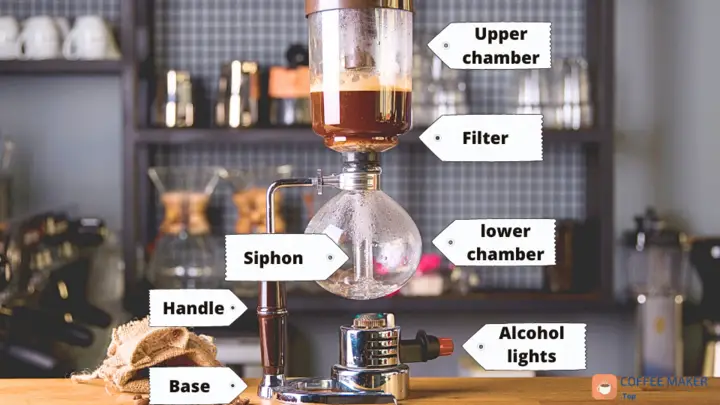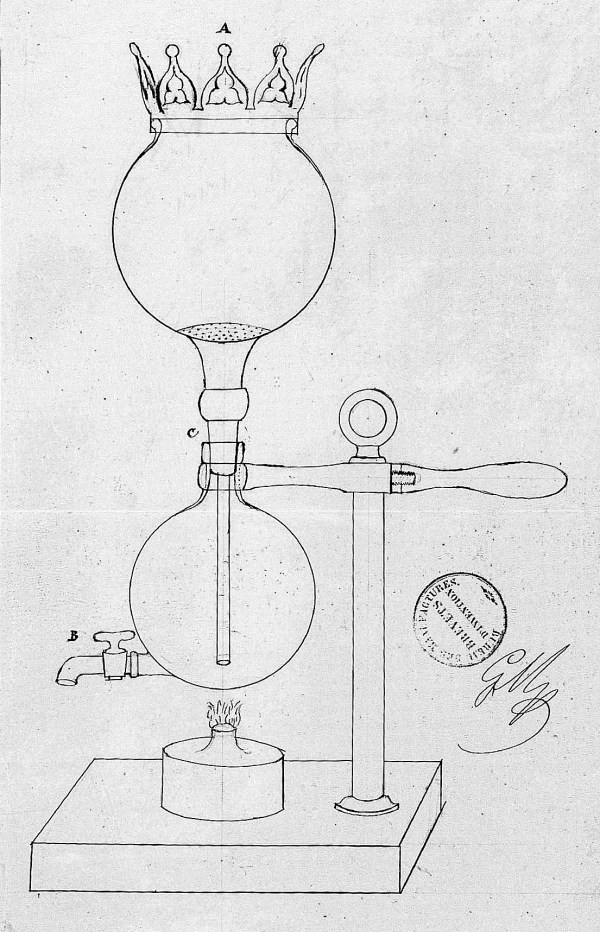Are you in search of a coffee experience that goes beyond the traditional? Do you crave that extra touch of distinction and pleasure that comes with artisanal coffee preparations? If so, vacuum coffee makers are your answer.
Also known as Cona or siphon coffee machines, these unique devices offer a completely manual approach to brewing. The result is a robust and flavourful cup with more pronounced and intense aromas than filtered coffees.
In the vacuum system, water boils at a lower temperature—around 70°C—allowing the coffee to retain its full range of sensory properties. Once you try them, you’ll be captivated by the incredible results they deliver.
What is a siphon coffee machine, and what are its components?
Siphon coffee machines, famed for their elegance, are mainly made of borosilicate glass. However, the ingenuity of their design goes beyond mere glasswork.
Borosilicate glass, prized for its durability and ability to withstand extreme temperature differences, is the material of choice for siphon coffee machines.
Its extraordinary resistance to thermal shock ensures that the glass does not crack or break when exposed to sudden changes in temperature during the brewing process.
This unique property not only ensures the longevity of the brewer but also contributes to the safety and reliability of the brewing experience.
In addition to the glass components, siphon coffee brewers have other essential elements. A typical configuration includes two chambers: a lower chamber for water and an upper chamber for ground coffee. These chambers are connected by a thin tube or ‘siphon’, which facilitates the movement of water vapour and ground coffee between the chambers.

In addition, siphon coffee brewers incorporate a filter. This assembly, often consisting of a metal or fabric filter, ensures that the brewed coffee is free of sediment or grounds, resulting in a clean and refined cup of coffee.
The combination of borosilicate glass, the dual chamber system and the filtering mechanism work harmoniously to create a visually captivating brewing process while extracting maximum flavour from the coffee grounds.
How vacuum (siphon) coffee brewers work
When it comes to vacuum coffee machines, understanding the brewing process reveals the captivating magic behind the name. Let’s dive into the fascinating mechanics of these machines.
The brewing process begins by filling the lower container of the coffee machine with water. Underneath, a heat source in the form of an alcohol container applies gentle heat to the water. As the temperature rises, the water gradually reaches boiling point and turns to steam, rising to the upper container where the ground coffee awaits.
Unlike drip or espresso machines, which rely on filtering, siphon coffee machines use an infusion process to extract the flavours we love.
Now, it’s time for the “vacuum” to take centre stage (ever wonder why these machines are called “vacuum”?).
The top and bottom containers must be screwed together and sealed tightly to create the vacuum effect. Once all the coffee has risen, stir gently with a spoon or non-metallic utensil and turn off the heat source.
Now comes the exciting part!
As the heat source is turned off, the air in the lower container begins to cool, creating a vacuum effect. This vacuum forces the coffee brewed in the upper container back into the lower chamber, ready to be savoured.
This unique process sets vacuum brewers apart from other brewing methods, such as Moka machines, where the coffee always remains at the top.
One of the distinctive qualities of siphon coffee, or vacuum coffee, is its exceptional cleanliness. Despite its delicate nature, this brewing method produces a robust cup of coffee, free of impurities and enriched with nuanced flavours and captivating aromas.
The absence of contact with metallic elements contributes to the purity and richness of the final brew.
Pros and cons of siphon coffee makers:
Like any brewing method, Siphon coffee makers come with their own advantages and considerations. Let’s explore the distinct pros and cons associated with these captivating devices.
Advantages:
- Exceptional quality coffee: Produces pure and aromatic brews that are highly regarded.
- Engaging brewing ritual: The process captivates coffee lovers and adds a touch of spectacle.
- No need for electricity: Allows for coffee preparation directly at the table.
Considerations:
- Fragile instruments: Delicate handling is required to prevent breakage, particularly during cleaning and storage.
- Risk of overheating: Glass can explode if the heat source is not promptly extinguished.
- Challenging cleaning: Narrow openings in the containers make cleaning a bit more difficult.
- Careful cleaning: Avoid using soap or toxic cleaning products to preserve the flavours of future brews.
See how a vacuum coffee maker works
Discover the captivating world of siphon coffee brewing in this insightful video. Join Paul Whitehead from Alchemy Cafe as he showcases the intricate process of brewing coffee using a siphon. From the precise measurements to the mesmerizing visual spectacle, siphon brewing offers a unique and sophisticated experience.
Get ready to delve into the art and science of siphon coffee brewing and uncover the remarkable results it produces:
The price range of vacuum coffee makers
When considering the purchase of a vacuum coffee maker, it’s essential to be aware of the price range associated with these exquisite brewing devices. In comparison to other types of coffee makers, vacuum coffee makers tend to have a higher price tag.
Let’s delve into the factors that contribute to their pricing and explore the options available in the market.
Generic price range
On average, siphon coffee makers typically range around £100, although prices vary depending on size and release year. Some premium models can even reach approximately £200, offering exceptional craftsmanship and advanced features.
Size options and capacities
Siphon coffee machines come in various sizes, offering different cup capacities. Options include models with 2 cups, 3 cups, 4 cups, or 5 cups, with the size of the glass determining their specific capacity.
The rise of Japanese siphon coffee makers
Although commonly referred to as Japanese siphon coffee makers, it’s interesting that they were not originally invented in Japan. These coffee makers trace their origins back to Germany in the early 20th century.

However, they experienced a period of obscurity until Japanese baristas and coffee enthusiasts rediscovered and popularized them. As a result, they adopted the name “Japanese siphon coffee maker” in the collective imagination.
Hario, a Japanese brand renowned for its exceptional quality glassware, has become synonymous with the Japanese siphon coffee maker and is widely recognized as a leader in this brewing method.
Best-Selling Vacuum Coffee Makers in 2023
In 2023, one of the top-selling vacuum coffee makers on the internet continues to be from the reputable Hario brand. To stay updated on the current rankings and options, it’s advisable to refer to our regularly updated resources.
